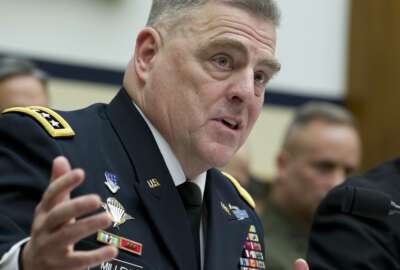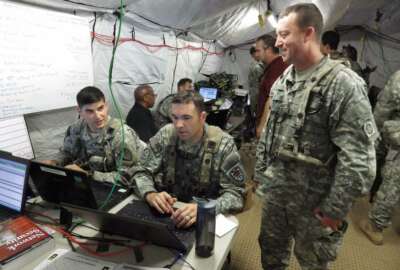
Air Force using Rapid Capabilities Office lessons on other programs
The Air Force is creating a blanket charter based on its RCO that will help acquisition programs move faster.
The Air Force is using its Rapid Capabilities Office as a model to speed up some of its other acquisition plans in the future.
As more acquisition programs move from the Defense Department’s acquisition office back to Air Force control, the service is taking the lessons it’s learned from the Rapid Capabilities Office and applying them more broadly, said Lt. Gen. Arnold Bunch, the military deputy for the Air Force assistant secretary for acquisition.
“We have taken the charter that the Rapid Capabilities Office was formed on. We have modified that charter. … What we are trying to do is inculcate that culture across the acquisition enterprise,” Bunch said during an Oct. 17 speech at an Air Force Association event in Arlington, Virginia. “We have morphed that charter so that we can apply it broadly across the Air Force.”
Bunch said the goal is to identify areas where the Air Force can form small teams that will streamline reviews and get them out of the “regular churn” of other programs.
Those select programs would have a board of directors that oversees the programs. The board of directors will be made up of the Air Force secretary, the Air Force chief of staff, a representative from the Air Force acquisition office and if the program is managed by the DoD, then the Pentagon’s acquisition, technology and logistics office will have a representative on the board as well.
“Instead of writing a charter every time I want to go fast on a program, I have a blanket charter where I can sign a memo and tell the program executive officer, ‘You execute under these authorities, here’s the charter, go run it,’” Bunch said.
The announcement comes as DoD is continuing to move programs from its acquisition office to the service as mandated by Congress in the 2016 Defense Authorization Act.
The thought process is the services should have authority over programs that will affect them, which is how acquisition programs were run back in the 1980s.
Last week, Defense Undersecretary for Acquisition, Logistics and Technology Ellen Lord said DoD is working to comply with the 2016 law. Lord said she is looking through the major acquisition programs right now and is looking at transitioning a bulk of them back to the services. The only programs that will stay within the acquisition office are extremely complex programs or programs that are part of multiple services.
The Air Force has had a fair amount of success with its Rapid Capabilities Office since it stood up the endeavor in 2003. The office is responsible for the development of the B-21.
Latest Air Force News
The Army set up its Rapid Capabilities Office last year based on the Air Force model.
“A goal of the Rapid Capabilities Office is to prioritize cross-domain and integrated solutions. It will put those solutions in front of senior leaders in enabling us to provide necessary pressure at the start of the process to drive innovation, continuous improvement and iteration,” said then-Army Secretary Eric Fanning during the RCO rollout last August.
Now the Air Force is the one taking a page from the Army playbook, as the Army announced last week it was reworking its whole acquisition office.
The Army wants to have all of the organizations that currently have a hand in developing and fielding new capabilities under “one roof,” said Ryan McCarthy, the acting secretary of the Army.
“We look at this as a restructuring, not creating something new,” McCarthy said. “It’s merging roles and responsibilities together in the way you’d merge companies, or divisions within a company. When the economy changes, a company divests capabilities it doesn’t need, it merges to get economies of scale to fuse people and information so that it moves faster. We haven’t done that in 40 years. We haven’t even looked at it. What we’ve done periodically is put pieces in place: we created the Army Research and Development Command, we created the Army Capabilities Integration Center and other things. We’ve upgraded the pieces, but fusing them together to make the system go faster is our goal in this particular case.”
While the Air Force’s expansion of its Rapid Capabilities Office is not as drastic as the Army reorganization, it may have some similar effects.
Copyright © 2025 Federal News Network. All rights reserved. This website is not intended for users located within the European Economic Area.
Scott Maucione is a defense reporter for Federal News Network and reports on human capital, workforce and the Defense Department at-large.
Follow @smaucioneWFED
Related Stories





